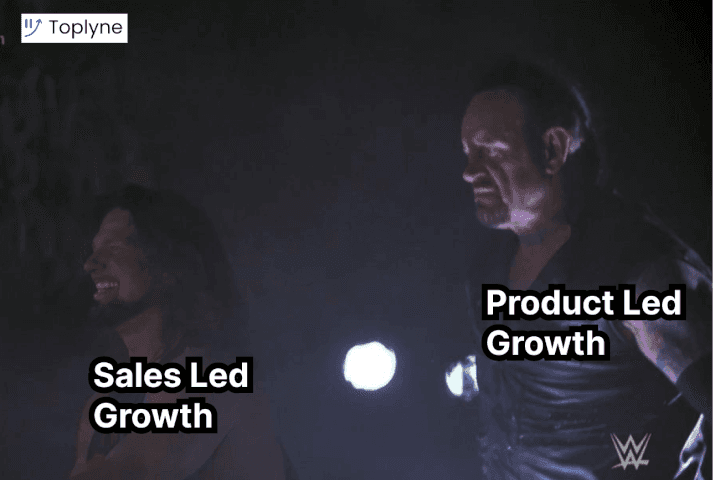5 Fool-Proof Steps For B2C Product-Led Growth
5 Fool-Proof Steps For B2C Product-Led Growth
5 Fool-Proof Steps For B2C Product-Led Growth
Discover what B2C product-led growth is and the five essential steps to execute a kickass product-led strategy for your B2C business.
Discover what B2C product-led growth is and the five essential steps to execute a kickass product-led strategy for your B2C business.
Discover what B2C product-led growth is and the five essential steps to execute a kickass product-led strategy for your B2C business.



B2C product-led growth (PLG) is a business model where the product drives user acquisition and retention.
Instead of your sales or marketing peeps telling the customer…

This PLG model relies on the product to speak for itself.
How?
By giving users a first-hand experience of the product.
Companies like Duolingo, AirBnB, and Bumble are the rockstars of the B2C product-led growth world.
In this article, we’ll explore what B2C product-led growth is and why product-led growth is a winning mantra for B2C companies. We’ll then give you five surefire ways to build an effective B2C product-led growth strategy.
Let’s begin!
What is B2C Product-Led Growth?
B2C product-led growth is a business strategy where the product instead of your sales team drives the customer acquisition, expansion, conversion, and retention of a PLG company.
Even though B2C companies (for whom user = buyer) have been focusing on product experience for years, they may not have called it “product-led” per se.
Psst 🤫… they mean the same thing.

Is your sales team wondering how B2C product-led growth works?
A product-led company relies on a freemium or free trial revenue model that allows users to experience the product they’re paying for without the intervention of the marketing or sales team.
You depend on your product and your customers to drive your revenue growth —which is much more efficient than sales-led growth or marketing led growth.
But is product-led growth the “OG” solution for B2C companies?
Let’s find out.
Why is Product-Led Growth Perfect For B2C Companies?
While a product-led growth strategy (PLG strategy) works for B2C and B2B companies, it’s a match made in heaven 💑 for B2C brands.
Here’s why:
B2B sales team or marketing team targets a group of stakeholders like product managers, product leaders, etc., which can delay purchasing decisions and user acquisition - for example, buying Slack’s paid subscription for the entire team. In contrast, a B2C product-led company usually deals with individual buyers who make decisions spontaneously, like buying Spotify’s premium plan for personal use.
B2B brands usually require more rational product marketing or messaging as buyers are highly informed and need a specific return on investment (ROI). However, B2C buyers are typically driven by emotions, so there’s less friction in the sales funnel.
B2C product-led growth tends to have a shorter sales cycle as companies make sales at the very first touchpoint, like buying a Netflix subscription.
Most B2C companies deal with lower ticket sizes per transaction, so devoting less time to each transaction means a lower customer acquisition cost.
While you’re at it, also check out what B2B product-led growth entails.
However, the B2C market is still a highly competitive arena where thousands of companies target the same user, urging them to choose…

Then, how can your product marketing team make your product stand out?
Wait for it 🤚
(drumroll)
By having a rock-solid B2C product-led growth strategy.
And no, you don’t need to sign up for a pricey product management course to create an incredible product-led strategy.
We’re giving you first-row seats to learn the trick of the trade - for Free. 😉
Let’s look at the five essential steps that can help product managers execute a fantastic B2C product-led strategy for SaaS growth.
Five Key Steps To Create a Fool-Proof B2C Product-Led Growth Strategy
Here are the five fundamental steps that your product-led SaaS growth strategy should have:
1. Design a Product That Delivers Value
Remember, even if you’re a SaaS company with a great product, you’re still competing with several other players in the market.
Your PLG strategy should focus on creating a unique offering that can deliver on the values it promises and offers a great customer experience. And for that, product design plays a crucial role.
And no, by design, we don’t mean having a “pretty- or cute-looking” product.

A solid product design ensures a hassle-free user experience, minimal friction, sticky features, and Short Time-To-Value (we’ll come back to this later.)
For example, Duolingo, with 37 million users, is revolutionizing the product experience with the way people can learn different languages online, and that too for free. Its top features like gamified learning, progressive lessons, and goal setting are a big hit amongst its users.
Moreover, personalizing your great product at an individual level is what’s going to solidify your value proposition. 💪
Let's take Netflix here.
This popular streaming service has got more than 140 million paid subscribers.
The reason for its popularity?
Netflix has got a dedicated team of data scientists that works on offering personalization to users in terms of the right shows, episodes, previews, etc. And, of course, it does deliver on its promise by being the “king of content” 👑.
2. Offer Free Trials and Ensure Seamless Onboarding
For product-led growth marketing, your efforts should primarily involve getting the users to try the product themselves.
For example, apps like Bumble offer different pricing models that allow users to get their hands quickly on the app without going through sales or marketing hoops.
The pricing models include:
Free trials: Users get to experience the entire product for a limited period of time - usually 14 or 30 days.
Freemiums: Allow users to continue using the product indefinitely, with some feature restrictions.
Premium Plans: Like Bumble Boost and Bumble Premium offer additional features and visibility.
While everyone loves free stuff, the job of growth teams doesn’t end here.
As soon as a user signs up for your product, it can be overwhelming for them to try out a laundry list of features.

If your product strategy doesn't include walking your user through how everything works, they won’t think twice before abandoning your product.
Yikes!
Indeed, not a great place to be in, right?
The solution - Once a product-qualified lead begins using your product, offer them a thoughtful onboarding experience. It can be through how-to videos, in-app messaging, chatbots, virtual tours, etc.
Duolingo is a master at this. The app guides visitors through a quick translation exercise, showing them how easy it’s to learn a new language on this platform. It allows users to experience the product before asking them to commit to it with signup.
Explore some of the best ways to create an incredible product led onboarding experience.
3. Prompt at the Right Time
Great, your product team has got prospective users to sign up and offered them an easy-breezy onboarding experience. But giving them free and easy access won’t improve your customer acquisition.
Then, how will your sales team convert prospective customers to paid users?
Simple - Keep them hooked on your product by using prompts.
In-app prompts are a great marketing tactic to help your customers form habits and upsell additional features of your product.
For example, Spotify allows its free users to skip six songs per hour, after which they’re prompted to upgrade to a premium account.
However, using prompts is a fine line to tread.🚶♂️
Why?
Prompt the customer too early, and you could fall below the engagement curve. Wait for too long, and it’ll render your prompts useless.
You don’t want users to hit the paywall right at the welcome page. But you also don’t want to prompt them to create team accounts when the user has already been using your product for over six months.
Else, be prepared to hear…🥴

A smart move for a software company is to gate premium parts of the product behind such prompts.
Like Dropbox, which uses upsell prompts to remind users about the restrictions of its free plan. It uses these prompts quite persistently yet subtly to offer users regular opportunities to upgrade.
You could also employ virality and network effects like “share to extend your trial or unlock some premium features.”
Bottomline - strike when the iron is still hot.🔨
4. Identify Key Product Growth Metrics
It’s essential for a product manager to have useful growth metrics and align different teams (like marketing, customer success, or sales team) around them to improve customer experience.
Some of the critical product growth metrics include:
Time to Value (TTV): Time taken by new users to realize the value they derive from the product. The shorter your product’s time to value, the quicker will be your revenue growth.
Net Churn: The net percentage of total Monthly Recurring Revenue (MRR) lost from existing users during a period. A SaaS company should try to get its MRR churn down to zero or even negative, as it can quickly suck the blood out of your business.
5. Use Behavioral Analytics To Measure and Grow
Data-driven decisions based on user behavior become inevitable for product-led growth at any software company. You should know what users are doing with your SaaS product and why. 🕵️
Actions like abandoning a cart or skipping a song (in the case of Spotify) could reveal what your users find valuable on your app.
Likewise, you should keep an eye on the number of qualified leads converting to a paid plan or what user demographics drive maximum revenue growth.
But how do you measure such data points?
That’s where Toplyne steps in.
Toplyne is a platform that enables growth teams at any SaaS company to experiment with different conversion strategies and monetize their product led growth. This includes both self-serve as well as sales assisted conversions.
Using Toplyne, a B2C PLG company can connect behavioral, demographic, and billing data to business outcomes like new sales, upsell opportunities, and reduced churn.
Here’s How Toplyne Can Help You:
Build a 360° view: Marketing and customer success teams of a product-led growth company can use Toplyne to consolidate each user's product usage information, billing information, and communication history into a single view.
Segment users: Product-led companies can use Toplyne to categorize qualified leads that are likely to convert, upgrade, etc.

Integrate into workflows: This SaaS platform integrates with your existing marketing tools (Mixpanel, Amplitude, etc.). This allows customer success teams to examine active users with both high and low conversion potential.

It’s not a surprise that marketing teams of some popular product led companies like Canva, GrafanaLabs, and Invideo use Toplyne to identify users who are a perfect fit for their premium subscriptions.
So what are you waiting for?
Experience Toplyne Yourself And Skyrocket 🚀 Your PLG
Today, users want to experience the SaaS product first-hand rather than have customer service executives chasing them. This means a product-led approach is the way forward!
We hope the five essential steps above can help you craft a successful growth strategy. Moreover, taking the help of Toplyne for your PLG strategy can surely give you an edge over your competitors.
Sign up for Toplyne for free today and find out which of your users are more likely to go from freemium to premium!

B2C product-led growth (PLG) is a business model where the product drives user acquisition and retention.
Instead of your sales or marketing peeps telling the customer…

This PLG model relies on the product to speak for itself.
How?
By giving users a first-hand experience of the product.
Companies like Duolingo, AirBnB, and Bumble are the rockstars of the B2C product-led growth world.
In this article, we’ll explore what B2C product-led growth is and why product-led growth is a winning mantra for B2C companies. We’ll then give you five surefire ways to build an effective B2C product-led growth strategy.
Let’s begin!
What is B2C Product-Led Growth?
B2C product-led growth is a business strategy where the product instead of your sales team drives the customer acquisition, expansion, conversion, and retention of a PLG company.
Even though B2C companies (for whom user = buyer) have been focusing on product experience for years, they may not have called it “product-led” per se.
Psst 🤫… they mean the same thing.

Is your sales team wondering how B2C product-led growth works?
A product-led company relies on a freemium or free trial revenue model that allows users to experience the product they’re paying for without the intervention of the marketing or sales team.
You depend on your product and your customers to drive your revenue growth —which is much more efficient than sales-led growth or marketing led growth.
But is product-led growth the “OG” solution for B2C companies?
Let’s find out.
Why is Product-Led Growth Perfect For B2C Companies?
While a product-led growth strategy (PLG strategy) works for B2C and B2B companies, it’s a match made in heaven 💑 for B2C brands.
Here’s why:
B2B sales team or marketing team targets a group of stakeholders like product managers, product leaders, etc., which can delay purchasing decisions and user acquisition - for example, buying Slack’s paid subscription for the entire team. In contrast, a B2C product-led company usually deals with individual buyers who make decisions spontaneously, like buying Spotify’s premium plan for personal use.
B2B brands usually require more rational product marketing or messaging as buyers are highly informed and need a specific return on investment (ROI). However, B2C buyers are typically driven by emotions, so there’s less friction in the sales funnel.
B2C product-led growth tends to have a shorter sales cycle as companies make sales at the very first touchpoint, like buying a Netflix subscription.
Most B2C companies deal with lower ticket sizes per transaction, so devoting less time to each transaction means a lower customer acquisition cost.
While you’re at it, also check out what B2B product-led growth entails.
However, the B2C market is still a highly competitive arena where thousands of companies target the same user, urging them to choose…

Then, how can your product marketing team make your product stand out?
Wait for it 🤚
(drumroll)
By having a rock-solid B2C product-led growth strategy.
And no, you don’t need to sign up for a pricey product management course to create an incredible product-led strategy.
We’re giving you first-row seats to learn the trick of the trade - for Free. 😉
Let’s look at the five essential steps that can help product managers execute a fantastic B2C product-led strategy for SaaS growth.
Five Key Steps To Create a Fool-Proof B2C Product-Led Growth Strategy
Here are the five fundamental steps that your product-led SaaS growth strategy should have:
1. Design a Product That Delivers Value
Remember, even if you’re a SaaS company with a great product, you’re still competing with several other players in the market.
Your PLG strategy should focus on creating a unique offering that can deliver on the values it promises and offers a great customer experience. And for that, product design plays a crucial role.
And no, by design, we don’t mean having a “pretty- or cute-looking” product.

A solid product design ensures a hassle-free user experience, minimal friction, sticky features, and Short Time-To-Value (we’ll come back to this later.)
For example, Duolingo, with 37 million users, is revolutionizing the product experience with the way people can learn different languages online, and that too for free. Its top features like gamified learning, progressive lessons, and goal setting are a big hit amongst its users.
Moreover, personalizing your great product at an individual level is what’s going to solidify your value proposition. 💪
Let's take Netflix here.
This popular streaming service has got more than 140 million paid subscribers.
The reason for its popularity?
Netflix has got a dedicated team of data scientists that works on offering personalization to users in terms of the right shows, episodes, previews, etc. And, of course, it does deliver on its promise by being the “king of content” 👑.
2. Offer Free Trials and Ensure Seamless Onboarding
For product-led growth marketing, your efforts should primarily involve getting the users to try the product themselves.
For example, apps like Bumble offer different pricing models that allow users to get their hands quickly on the app without going through sales or marketing hoops.
The pricing models include:
Free trials: Users get to experience the entire product for a limited period of time - usually 14 or 30 days.
Freemiums: Allow users to continue using the product indefinitely, with some feature restrictions.
Premium Plans: Like Bumble Boost and Bumble Premium offer additional features and visibility.
While everyone loves free stuff, the job of growth teams doesn’t end here.
As soon as a user signs up for your product, it can be overwhelming for them to try out a laundry list of features.

If your product strategy doesn't include walking your user through how everything works, they won’t think twice before abandoning your product.
Yikes!
Indeed, not a great place to be in, right?
The solution - Once a product-qualified lead begins using your product, offer them a thoughtful onboarding experience. It can be through how-to videos, in-app messaging, chatbots, virtual tours, etc.
Duolingo is a master at this. The app guides visitors through a quick translation exercise, showing them how easy it’s to learn a new language on this platform. It allows users to experience the product before asking them to commit to it with signup.
Explore some of the best ways to create an incredible product led onboarding experience.
3. Prompt at the Right Time
Great, your product team has got prospective users to sign up and offered them an easy-breezy onboarding experience. But giving them free and easy access won’t improve your customer acquisition.
Then, how will your sales team convert prospective customers to paid users?
Simple - Keep them hooked on your product by using prompts.
In-app prompts are a great marketing tactic to help your customers form habits and upsell additional features of your product.
For example, Spotify allows its free users to skip six songs per hour, after which they’re prompted to upgrade to a premium account.
However, using prompts is a fine line to tread.🚶♂️
Why?
Prompt the customer too early, and you could fall below the engagement curve. Wait for too long, and it’ll render your prompts useless.
You don’t want users to hit the paywall right at the welcome page. But you also don’t want to prompt them to create team accounts when the user has already been using your product for over six months.
Else, be prepared to hear…🥴

A smart move for a software company is to gate premium parts of the product behind such prompts.
Like Dropbox, which uses upsell prompts to remind users about the restrictions of its free plan. It uses these prompts quite persistently yet subtly to offer users regular opportunities to upgrade.
You could also employ virality and network effects like “share to extend your trial or unlock some premium features.”
Bottomline - strike when the iron is still hot.🔨
4. Identify Key Product Growth Metrics
It’s essential for a product manager to have useful growth metrics and align different teams (like marketing, customer success, or sales team) around them to improve customer experience.
Some of the critical product growth metrics include:
Time to Value (TTV): Time taken by new users to realize the value they derive from the product. The shorter your product’s time to value, the quicker will be your revenue growth.
Net Churn: The net percentage of total Monthly Recurring Revenue (MRR) lost from existing users during a period. A SaaS company should try to get its MRR churn down to zero or even negative, as it can quickly suck the blood out of your business.
5. Use Behavioral Analytics To Measure and Grow
Data-driven decisions based on user behavior become inevitable for product-led growth at any software company. You should know what users are doing with your SaaS product and why. 🕵️
Actions like abandoning a cart or skipping a song (in the case of Spotify) could reveal what your users find valuable on your app.
Likewise, you should keep an eye on the number of qualified leads converting to a paid plan or what user demographics drive maximum revenue growth.
But how do you measure such data points?
That’s where Toplyne steps in.
Toplyne is a platform that enables growth teams at any SaaS company to experiment with different conversion strategies and monetize their product led growth. This includes both self-serve as well as sales assisted conversions.
Using Toplyne, a B2C PLG company can connect behavioral, demographic, and billing data to business outcomes like new sales, upsell opportunities, and reduced churn.
Here’s How Toplyne Can Help You:
Build a 360° view: Marketing and customer success teams of a product-led growth company can use Toplyne to consolidate each user's product usage information, billing information, and communication history into a single view.
Segment users: Product-led companies can use Toplyne to categorize qualified leads that are likely to convert, upgrade, etc.

Integrate into workflows: This SaaS platform integrates with your existing marketing tools (Mixpanel, Amplitude, etc.). This allows customer success teams to examine active users with both high and low conversion potential.

It’s not a surprise that marketing teams of some popular product led companies like Canva, GrafanaLabs, and Invideo use Toplyne to identify users who are a perfect fit for their premium subscriptions.
So what are you waiting for?
Experience Toplyne Yourself And Skyrocket 🚀 Your PLG
Today, users want to experience the SaaS product first-hand rather than have customer service executives chasing them. This means a product-led approach is the way forward!
We hope the five essential steps above can help you craft a successful growth strategy. Moreover, taking the help of Toplyne for your PLG strategy can surely give you an edge over your competitors.
Sign up for Toplyne for free today and find out which of your users are more likely to go from freemium to premium!

Related Articles




Behavioral Retargeting: A Game-Changer in the Cookieless Era
Unlock the power of behavioral retargeting for the cookieless future! Learn how it personalizes ads & boosts conversions. #behavioralretargeting




All of Toplyne's 40+ Badges in the G2 Spring Reports
Our customers awarded us 40+ badges in G2's Summer Report 2024.




Unlocking the Full Potential of Google PMax Campaigns: Mastering Audience Selection to Double Your ROAS
Copyright © Toplyne Labs PTE Ltd. 2024
Copyright © Toplyne Labs PTE Ltd. 2024
Copyright © Toplyne Labs PTE Ltd. 2024
Copyright © Toplyne Labs PTE Ltd. 2024